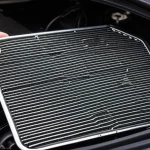Actionable Driving Habits to Improve Fuel Efficiency
Mastering efficient driving techniques is key to maximize fuel efficiency consistently. One of the most effective practices is smooth acceleration paired with gentle braking. Rapid acceleration or sudden braking consumes more fuel as the engine demands bursts of power. By applying steady pressure on the gas pedal and anticipating stops, drivers can significantly enhance mileage.
Maintaining a steady speed is another cornerstone of the best driving habits for fuel economy. Utilizing cruise control on highways helps keep a constant pace and avoids the fuel waste caused by frequent speed fluctuations. When cruise control is active, the engine runs at optimal efficiency, reducing unnecessary fuel consumption.
Topic to read : Comprehensive guide: ensuring your custom car meets uk emissions standards
Unnecessary idling, surprisingly, still affects many drivers’ fuel economy. Idling for prolonged periods burns fuel without moving the vehicle, thus decreasing overall fuel efficiency. Turning off the engine during longer stops can save fuel and reduce emissions.
Adopting these habits—smooth acceleration, steady speeds, and minimal idling—creates a cumulative effect that improves your car’s fuel performance and reduces costs. With these techniques, drivers can confidently maximize fuel efficiency while enjoying a smoother, less stressful driving experience.
Also to see : Mot differences unveiled: key distinctions between electric and diesel vehicles in the uk
Vehicle Maintenance Essentials for Peak Fuel Economy
Simple steps to optimise your vehicle’s performance
Regular fuel economy maintenance is crucial for keeping your car efficient and saving on fuel costs. One of the most effective car maintenance tips is ensuring timely oil changes. Fresh oil reduces engine friction, helping your engine run smoothly and use fuel more efficiently. Similarly, replacing air filters regularly prevents dirt buildup that can choke your engine, leading to improved combustion and better mileage.
Proper tire inflation is often overlooked but vital. Underinflated tires increase rolling resistance, forcing your engine to work harder and burn more fuel. Maintaining the recommended tire pressure and ensuring correct wheel alignment improves fuel economy by reducing unnecessary drag.
Addressing engine issues promptly and adhering to scheduled tune-ups can significantly boost your vehicle’s performance. Tune-ups include checking spark plugs, ignition timing, and fuel injection systems, all of which affect how efficiently your car consumes fuel.
By focusing on these vehicle maintenance essentials, you not only optimise vehicle performance but also extend your car’s lifespan and reduce emissions. Keeping these maintenance tasks on track is a smart investment in both your savings and the environment.
Smart Route Planning for Reduced Fuel Use
Efficient route planning is crucial for minimizing fuel consumption in daily travel. By leveraging real-time traffic data, drivers can avoid congested routes, thereby reducing idling time and unnecessary acceleration that increase fuel use. This approach offers a direct way to achieve fuel-saving navigation by steering clear of traffic jams or accident-prone areas.
Another key factor in trip optimization is combining errands and trips. Planning routes that cluster multiple destinations together helps reduce the total miles driven. This strategy lowers fuel expenditure because the engine runs less overall and wastes less energy on frequent stops and starts.
Choosing optimal travel times also contributes significantly to fuel savings. Driving during off-peak hours or when traffic flows smoothly prevents inefficient stop-start driving that burns more fuel. Smart route planning integrates these elements to optimize not just the path but also the timing of journeys, supporting environmentally friendly and cost-effective travel.
Altogether, efficient route planning blends technology and thoughtful scheduling to enhance trip optimization, making it easier for drivers to save fuel without sacrificing convenience. This method reflects a practical solution for anyone looking to reduce their carbon footprint and fuel expenses simultaneously.
Role of Technology in Maximizing Fuel Economy
Small changes in driving behavior can lead to significant fuel savings, especially when combined with fuel-saving technology. Today’s car tech for fuel efficiency includes advanced onboard systems and mpg apps designed to help drivers monitor fuel consumption in real time. These apps provide instant feedback on acceleration, braking, and idling, guiding users to adjust habits that waste fuel.
Another critical component is Advanced Driver Assistance Systems (ADAS). Features like adaptive cruise control, lane-keeping assistance, and eco-driving modes optimize driving patterns and reduce unnecessary acceleration or braking. These automated systems enhance fuel economy by promoting smooth, consistent driving—key to achieving better miles per gallon.
Telematics technology, employed by fleet managers and individual drivers alike, collects data on vehicle performance and driving habits, translating complex metrics into actionable insights. Case studies demonstrate that drivers using telematics can improve fuel efficiency by up to 15%. This technology highlights specific inefficiencies, such as excessive idling or aggressive driving, enabling targeted improvements.
By harnessing these technologies—fuel-saving technology, mpg apps, and ADAS—drivers gain not only better fuel economy but also a clearer understanding of how their behavior directly impacts mileage and emissions.
Pro Tips and Real-World Strategies from Expert Drivers
Professional driving tips often prioritize fuel economy by focusing on smooth acceleration and deceleration. Expert drivers avoid sudden braking and rapid starts, which burn more fuel. Instead, they maintain steady speeds, leveraging momentum to enhance fuel efficiency. This practice can reduce fuel consumption significantly over long hauls.
Another key strategy involves monitoring engine RPM closely. Professionals keep the engine running within optimal RPM ranges to prevent wasting fuel, a method often overlooked by everyday drivers. Additionally, fleet operators implement route optimization software to minimize idling and delays, further improving overall efficiency.
Case studies highlight striking differences: while casual drivers may see fuel savings of 5-10%, professionals with refined habits can achieve up to 20% improvement. Real-world fuel efficiency gains arise not only from driving habits but also consistent maintenance, like timely tire inflation and filter changes.
In essence, adopting professional driving tips isn’t just about driving skill—it’s about integrating multiple tactics into a cohesive approach. For those curious about detailed strategies, exploring expert fuel economy advice provides a solid foundation to start improving your own fuel usage immediately.


